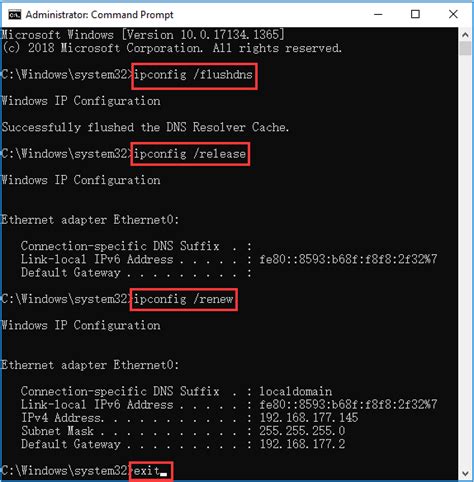Troubleshooting DNS Server Unavailability

DNS (Domain Name System) is a critical component of the internet infrastructure, acting as a translator between human-readable domain names and machine-readable IP addresses. When DNS servers encounter issues, it can lead to a variety of problems, ranging from website accessibility issues to disrupted network connectivity. In this comprehensive guide, we will delve into the world of DNS troubleshooting, exploring the causes of DNS server unavailability and providing expert insights on how to identify and resolve these issues effectively.
Understanding DNS Server Unavailability

DNS server unavailability can manifest in several ways, often causing frustration and confusion for both users and network administrators. Common symptoms include:
- Website access issues: Users may experience difficulty accessing specific websites or online services, often encountering error messages like “Server not found” or “DNS lookup failed”.
- Network connectivity problems: Network-wide disruptions can occur, affecting multiple devices and applications, leading to slow internet speeds or complete loss of connectivity.
- Email delivery delays or failures: DNS issues can disrupt email delivery, causing delays or even failed attempts to send and receive emails.
- Application connectivity issues: Certain applications that rely on DNS resolution may malfunction or fail to connect to their respective servers.
These symptoms can have various underlying causes, ranging from simple configuration errors to more complex issues with network infrastructure. By understanding the potential causes and employing effective troubleshooting techniques, we can identify and resolve DNS server unavailability issues efficiently.
Common Causes of DNS Server Unavailability

There are several common factors that can contribute to DNS server unavailability. Identifying the root cause is crucial for implementing the appropriate solution. Here are some of the most prevalent causes:
1. Misconfiguration
Misconfiguration is one of the most frequent causes of DNS server issues. This can include:
- Incorrect DNS server settings: Devices may be configured to use the wrong DNS server addresses, leading to failed resolution attempts.
- Outdated or incompatible DNS records: Outdated DNS records can cause issues with domain resolution, especially when changes have been made to the domain’s configuration.
- Incorrect zone transfers: Misconfiguration of zone transfers between primary and secondary DNS servers can disrupt DNS services.
Regularly auditing and updating DNS configurations can help prevent these issues from occurring.
2. Network Infrastructure Issues
Network infrastructure plays a vital role in the smooth operation of DNS services. Problems with network infrastructure can include:
- Network congestion: High network traffic or congestion can overwhelm DNS servers, leading to delays or failures in DNS resolution.
- Router or firewall misconfigurations: Improper configurations of routers or firewalls can inadvertently block DNS traffic, causing DNS resolution issues.
- Network outages: Physical network failures or disruptions can prevent DNS servers from communicating with clients, resulting in unavailability.
Regular network monitoring and proactive maintenance can help identify and address infrastructure issues before they escalate.
3. DNS Server Failures
Sometimes, DNS server failures can occur due to various reasons, such as:
- Hardware failures: Physical components of DNS servers, such as hard drives or network cards, can malfunction, leading to server crashes or unresponsiveness.
- Software bugs or updates: DNS server software may encounter bugs or issues during updates, causing instability or crashes.
- Overload or excessive queries: High volumes of DNS queries can overwhelm a server’s capacity, resulting in slow response times or complete failures.
Implementing proper server maintenance, regular software updates, and load balancing can help mitigate these issues.
Troubleshooting DNS Server Unavailability
When faced with DNS server unavailability, a systematic troubleshooting approach is essential. Here are some steps to follow:
1. Verify DNS Settings
Start by checking the DNS settings on the affected devices. Ensure that the correct DNS server addresses are configured and that they are reachable. Use tools like nslookup or dig to perform DNS queries and verify the accuracy of the settings.
2. Check Network Connectivity
Assess the network connectivity to identify any potential bottlenecks or disruptions. Use network monitoring tools to analyze traffic patterns and identify any anomalies. Ping and traceroute commands can help diagnose network-related issues.
3. Examine DNS Records
Examine the DNS records associated with the affected domains. Verify that the records are up-to-date and correctly configured. Check for any recent changes or modifications that may have caused the issues.
4. Monitor DNS Server Performance
Monitor the performance of the DNS servers to identify any abnormal behavior. Check for high query rates, excessive errors, or resource utilization issues. Monitoring tools like dnstop or DNS Query Sniffer can provide valuable insights into server performance.
5. Troubleshoot Individual Devices
If the issue is isolated to a specific device or network segment, focus on troubleshooting that device. Check for any software conflicts, firewall rules, or proxy settings that may be blocking DNS traffic. Resetting network settings or reinstalling network drivers can sometimes resolve the problem.
6. Contact DNS Provider
If the issue persists and you are using a third-party DNS provider, reach out to their support team. They may have additional troubleshooting steps or insights specific to their infrastructure.
Best Practices for Preventing DNS Server Unavailability
While troubleshooting is essential, preventing DNS server unavailability is even more crucial. Here are some best practices to consider:
- Regular DNS Audits: Conduct periodic audits of your DNS infrastructure to identify potential issues before they cause disruptions. Check for outdated records, misconfigurations, and potential security vulnerabilities.
- Redundancy and Failover: Implement redundancy measures to ensure high availability of DNS services. This can include using multiple DNS servers, load balancing, and implementing failover mechanisms.
- DNS Security Measures: Protect your DNS infrastructure against attacks and unauthorized access. Implement DNS security best practices, such as DNSSEC (Domain Name System Security Extensions), to enhance security and prevent data tampering.
- Network Monitoring and Alerting: Set up robust network monitoring systems to detect anomalies and potential issues early on. Implement alerting mechanisms to notify administrators of critical issues, allowing for prompt response and resolution.
Conclusion

DNS server unavailability can be a complex issue, but with the right knowledge and troubleshooting techniques, it can be effectively resolved. By understanding the common causes and following a systematic approach, network administrators can identify and mitigate DNS issues, ensuring a seamless and reliable internet experience for users.
What are some common symptoms of DNS server unavailability?
+Common symptoms include website access issues, network connectivity problems, email delivery delays, and application connectivity failures. Users may encounter error messages like “Server not found” or “DNS lookup failed.”
What are some best practices for preventing DNS server unavailability?
+Regular DNS audits, redundancy and failover mechanisms, DNS security measures, and robust network monitoring and alerting systems are essential for preventing DNS server unavailability.
How can I verify DNS settings on my device?
+You can use tools like nslookup or dig to query DNS servers and verify the accuracy of DNS settings on your device. These tools provide detailed information about DNS records and server responses.
What are some common causes of DNS server failures?
+Common causes of DNS server failures include hardware failures, software bugs or updates, and overload or excessive queries. Regular server maintenance and load balancing can help prevent these issues.
How can I monitor DNS server performance?
+You can use monitoring tools like dnstop or DNS Query Sniffer to monitor DNS server performance. These tools provide insights into query rates, error rates, and resource utilization, helping you identify potential issues.



